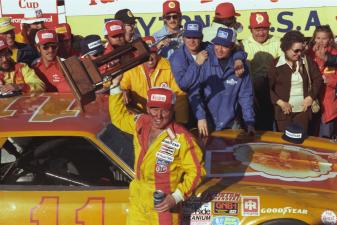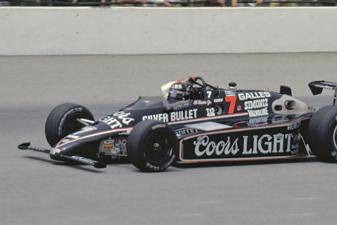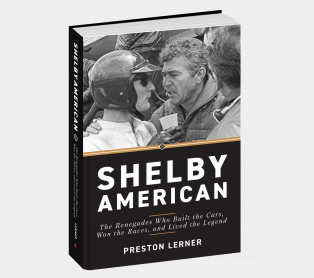Working at the Wild West

Celebrate 60 years of iconic automotive designer and manufacturer Shelby American and watch the saga unfold from the men and women who lived it with the new book Shelby American: The Renegades Who Built the Cars, Won the Races, and Lived the Legend. The legendary shop didn’t last long, but it was a flame that burned incandescently before being extinguished by corporate politics. In less than a decade, it created a legacy that will be revered as long as cars still roar around racetracks. In this excerpt from the book, read about some of the hijinks that took place at the LAX location of Shelby American.
As Shelby American grew, so did the PR Department. This created an opportunity for twenty-year-old Diana Trampe, a recent college graduate who was distraught after flubbing a secretarial skills test at Hughes Aircraft. Sobbing beside her father’s truck, she looked across Imperial Highway and saw an orderly collection of white cars—Mustangs ready to be converted into GT350s. For some reason, she thought they were Studebakers, and to cheer herself up, she decided to take a tour of the Studebaker factory. She drove up to the guard booth and was directed to a portable building. Before she could ask about taking a tour, the woman who greeted her said, “Are you the girl for the PR job?” Trampe may have been young, but she wasn’t stupid. “Yes!” she said immediately, even though she didn’t know what “PR” meant.
During her job interview with PR director Don Rabbitt, Trampe finessed her lack of secretarial skills. (She’d just earned a degree in political science.) Rabbit told her that she had to talk to somebody named Carroll Shelby. She was ushered into another area, where she met a lanky, middle-aged man with curly brown hair and a Texas accent. After a few minutes of nervous conversation about her college experience, she asked him, “Is Miss Carol coming soon?” Shelby muffled a laugh and told her, “Miss Carol is allowing me to do the interview.” Then he called down the hall to Rabbitt, “She’s fine!”
As a PR assistant—and, later, director of public relations—Day ghost-wrote magazine articles for Shelby, initiated an in-house newsletter called the Cobra Crier, and was responsible for providing cars and factory tours to celebrities ranging from Jerry Lewis, James Garner, and Tony Curtis to Twiggy, Gus Grissom, and Scott Carpenter. (Years later, after leaving Shelby American, she married Ray Geddes.) She also fielded complaints from air-traffic controllers at LAX whenever a Shelby American employee got busted for antics like racing at the airport. She would march down to the shop floor, put her hands on her hips and sternly declare, “You have to stop testing on an active taxiway. They want to shut us down!” And almost as soon as she’d climbed the stairs back to her office, she could hear tires squealing. “It was like the Wild West,” she said.
Mark Waco was a repeat offender. Before moving over to the race shop, he worked on GT350 production, installing scoops and valve covers. “Fortunately, I was at the end of the line, so I got to drive the cars off,” he said. “We found ways to drive them onto the taxiway. Today, you’d be dead in five minutes doing that. But back then, the pilots would just wave at you and give you the A-OK sign.”
Of course, Waco was only nineteen at the time, so he deserved something of a free pass. But the anything-goes mentality evidently applied equally well to veteran engine man Jim O’Leary. After working for hours to cure a miss in a 427 Cobra, he ran the car around a makeshift test track behind the hangars—though not on an active taxiway—to make sure the engine was okay. The wheels were spinning so luridly that the speedometer showed 100 miles per hour even though the car was going only 50 mph. But he thought to himself, ‘If Ken Miles can do it, I can do it.’ So he kept his foot in the throttle—and spun the car just as Shelby and some Ford execs were walking out. “And I thought, ‘Wow, this is my last day!’” O’Leary said. “But they never said a word.”
But the worst offenders were the pro drivers. Case in point: Bernie Kretzschmar remembers looking out the window of the west hangar one day and seeing Jim McLean showing off row after row of neatly parked GT350s to Dan Gurney and Jerry Grant. Gurney jumped in one and started turning tire-roasting 360s—with Grant right behind him, enveloping the cars in a cloud of smoke. Then Gurney peeled off past a row of brand-new cars, did an arcing U-turn at 80-plus mph and screamed in between two other rows of Mustangs. And where was Grant while Gurney was turning the parking lot into a temporary racetrack? Playing bumper tag with Gurney! “And I’m thinking, ‘Man, if they wreck in between all those cars. . .’” Kretzschmar recalled. They didn’t wreck, of course. Gurney and Grant parked the GT350s, and everybody went back to work—until Jerry Schwarz hollered, “Hey, one of the cars is on fire!”
Black smoke was swirling up from the car Gurney had been driving. The crew ran outside and checked under the hood. Nothing. Then they checked under the car and found the problem. Gurney had been standing on the brakes so hard that the rubber boot around the pistons in the calipers had caught fire. “Just another day at Shelby American,” Kretzschmar said.





